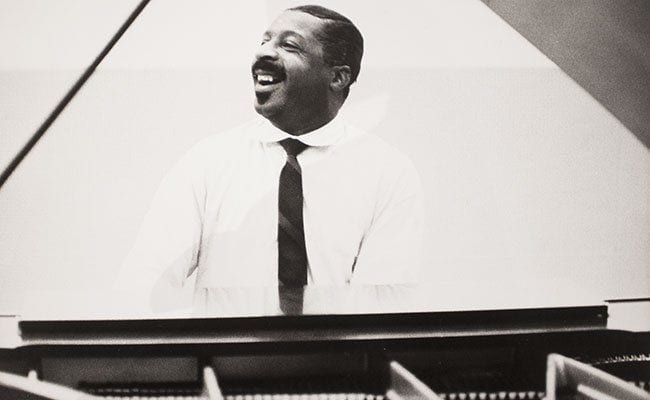
Despite his staunch refusal of any sort of stylistic evolution, pianist Erroll Garner was nonetheless a virtuoso on the instrument, if perhaps a bit too idiosyncratic and singular of a voice to be widely influential. Unlike his more studied peers, Garner never learned to read music and instead performed wholly by ear. This approach led to his utterly unique approach wherein his left hand tended to hold down the rhythm of a given song while his right would play slightly behind the beat. Coupled with his tendency to elongate song intros, approaching them much in the same rubato way as classical musicians, Garner tended to perform primarily within a solo or, at most, trio setting. This rhythmic flexing made it difficult for all but the most attentive sidemen to follow his lead.
With his often abstract, tension-filled intros, audiences were left wondering as to the identity of the next piece. This whimsical approach allowed Garner to make the most of his naturally virtuosic talents on the instrument while lending an air of mystery to the song itself. Throughout this collection of demonstration recordings captured in their rawest essence, Garner relies heavily on elongated, exploratory introductory statements, teasing out the melody and all its harmonic possibilities before settling in. Tackling a handful of standards, he breathes new life into otherwise staid tunes by bastardizing their very structure, rendering them virtually unrecognizable.
His read on the opening moments of “High Wire” bend and stretch the expected rhythmic coherence of the tune to its logical extremes, falling so far behind the beat as to threaten losing it entirely. Only at the last moment, his melodic phrases teetering on the razor’s edge, does he snap back in sync with the rhythm section, disaster averted. It’s a breath-taking approach that leaves the listener on the edge of their seat, waiting to see what transpires – tragedy or triumph.
Similarly, “I Want to Be Happy” begins as a smattering of notes seemingly deployed at random before all of the pieces suddenly lock together. From here the group is off and running, swinging the tune about as hard as possible, all the while Garner delivering an appropriately idiosyncratic solo that lies just this side of traditional. Borrowing from standard jazz phrasing, supplanting it with pop lyricism and elements of classicism, he shows off his well-earned status as a virtuoso on the instrument. Not only this, but his increasingly impassioned grunting and growling serves to underscore the effort being put into the performance, Garner giving his all as he pushes both the tune and his band mates ever onward. The recording both exclamation at track’s end of, “More!” (coming from Garner’s longtime manager Martha Glaser who pops up throughout the sessions) concisely sums up the overall feel of not only his performance of “I Want to Be Happy,” but the collection as a whole.
It’s an informal setting in which Garner and company can let loose and feel out these tunes for all they’re worth. Following Garner’s esoteric lead often proves something of a challenge, the rhythm section forced to maintain a machine-like groove behind Garner’s fragmented approach to rhythmic expression. His solo on “I’m Confessin’ (That I Love You)” lags so far behind the beat at times that it is as though he were performing on an entirely separate track from that of his rhythm section. And yet this push-pull helps to enliven would what otherwise be a fairly traditional piano trio outing.
The newly-unearthed Garner original “Wild Music” begins with a classically-informed tease of the melody that morphs into a stately run of syncopated right hand lines. Just as the piano sounds as though it were slowing to a crawl, the tune explodes into a jaunty, rhythmically intricate number that plays as the polar opposite of its introduction. This approach is a constant throughout that never manages to lose its impact and become formulaic. Instead, each offers a new and different take, often wildly outside the box, making for fascinatingly engaging listening.
His read of “Caravan” is perhaps the most idiosyncratic of them all, the melody chopped and fragmented, falling out of line with the chart’s chord progression only to fall in line during the driving solo section. Here his left hand hammers away on the off beats while his right flies across the keys, weaving in and out of the rhythm and driving the tune at a furious pace. “Satin Doll”, too, finds its recognizable melody bent and reshaped in all manner of ways before settling into something bordering on the recognizable.
These intimate performances, all recorded with his various road bands at studios in New York and Chicago between 1967 and 1971, help further support the case for Garner’s inimitable genius. From his grasp of playing outside the rhythmic and harmonic structure of a tune to his impassioned grunting throughout, Garner’s performances here are a marvel to behold. And with the clarity of sound presented, it feels like being in the room while the tape rolls, the bass to your left, drums to your right and Garner smack dab in the middle of it all. And while these performances likely won’t win any converts (jazz or otherwise), they will certainly reassure and please the faithful due to the inclusion of six previously unreleased Garner originals. Free-wheeling, endlessly melodic and a hell of a lot of fun to listen to, this is about as good as jazz piano gets.


![Call for Papers: All Things Reconsidered [MUSIC] May-August 2024](https://www.popmatters.com/wp-content/uploads/2024/04/all-things-reconsidered-call-music-may-2024-720x380.jpg)



